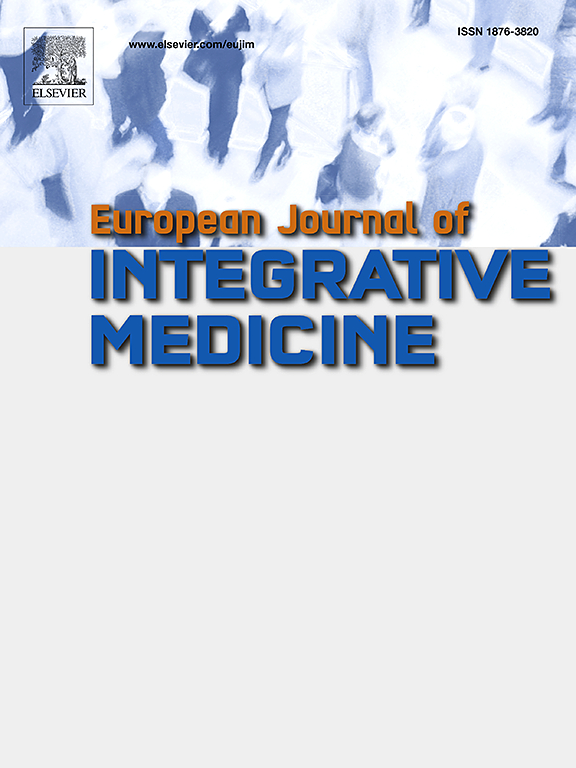Effectiveness of scalp acupuncture therapy combined with training on limb movement disorders after stroke: A systematic review and meta-analysis
IF 1.7
4区 医学
Q3 INTEGRATIVE & COMPLEMENTARY MEDICINE
引用次数: 0
Abstract
Introduction
Stroke patients often suffer from different degrees of disability, among which limb movement disorders (LMDs) are the most prevalent. Scalp acupuncture (SA) therapy combined with training has been widely used for LMD treatment after stroke. Whether SA therapy combined with training is superior to monotherapy or other therapies remains unknown. This review aimed to evaluate the effectiveness and safety of SA therapy combined with training for LMDs after stroke.
Methods
PubMed, EMBASE, Web of Science, and Cochrane Library databases were thoroughly searched for studies from inception to November 23, 2024. Fugl-Meyer Assessment (FMA), Modified Ashworth Scale (MAS), Berg Balance Scale (BBS), and Modified Barthel Index (MBI) were used to evaluate the effectiveness of SA therapy combined with training in treating LMDs after stroke. Weighted mean differences (WMDs) were calculated.
Results
A total of 4345 records were initially identified, and 26 studies were finally included. Compared to simple training, SA therapy combined with training had significant effects in the total score of FMA (WMD= 10.01, 95 %CI= 2.24, 17.78), the upper-extremity score of FMA (WMD= 6.35, 95 %CI=4.11, 8.59), the lower-extremity score of FMA (WMD= 2.69, 95 %CI= 1.49, 3.90), MAS (WMD= -0.47, 95 %CI= -0.72, -0.22), BBS (WMD= 3.52, 95 %CI= 0.55, 6.48), and MBI (WMD= 7.72, 95 %CI= 4.97, 9.56). No significant difference was found in adverse events (RR= 6.97, 95 %CI= 2.10, 23.11, P = 0.33). More significant effects in FMA-L and MAS were revealed after 12 weeks of treatment (all P interaction<0.01).
Conclusion
SA therapy combined with training can significantly improve FMA, MAS, BBS, and MBI to enhance limb function, with favorable safety profiles. 12 weeks of SA therapy combined with training often yields better improvements in lower limb motor function and limb spasticity. More RCTs of higher quality are needed to provide reliable support for these conclusions.
头皮针刺疗法结合训练治疗脑卒中后肢体运动障碍的有效性:一项系统综述和荟萃分析
脑卒中患者往往存在不同程度的残疾,其中肢体运动障碍(LMDs)最为常见。头皮针刺疗法结合训练已广泛应用于脑卒中后LMD的治疗。SA治疗联合训练是否优于单一治疗或其他治疗仍不清楚。本综述旨在评估脑卒中后低mds患者SA治疗联合培训的有效性和安全性。方法对spubmed、EMBASE、Web of Science、Cochrane Library等数据库进行全面检索,检索时间为建库至2024年11月23日。采用Fugl-Meyer量表(FMA)、改良Ashworth量表(MAS)、Berg平衡量表(BBS)和改良Barthel指数(MBI)评价SA联合训练治疗脑卒中后lmd的疗效。计算加权平均差(wmd)。结果初步筛选出4345条记录,最终纳入26篇研究。与单纯训练相比,SA治疗联合训练对FMA总分(WMD= 10.01, 95% CI= 2.24, 17.78)、FMA上肢评分(WMD= 6.35, 95% CI=4.11, 8.59)、FMA下肢评分(WMD= 2.69, 95% CI= 1.49, 3.90)、MAS (WMD= -0.47, 95% CI= -0.72, -0.22)、BBS (WMD= 3.52, 95% CI= 0.55, 6.48)、MBI (WMD= 7.72, 95% CI= 4.97, 9.56)均有显著影响。两组不良事件发生率差异无统计学意义(RR= 6.97, 95% CI= 2.10, 23.11, P = 0.33)。治疗12周后FMA-L和MAS的影响更为显著(P互作< 0.01)。结论sa治疗联合训练可显著改善FMA、MAS、BBS和MBI,增强肢体功能,且安全性较好。12周的SA治疗结合训练通常能更好地改善下肢运动功能和肢体痉挛。需要更多高质量的随机对照试验来为这些结论提供可靠的支持。
本文章由计算机程序翻译,如有差异,请以英文原文为准。
求助全文
约1分钟内获得全文
求助全文
来源期刊

European Journal of Integrative Medicine
INTEGRATIVE & COMPLEMENTARY MEDICINE-
CiteScore
4.70
自引率
4.00%
发文量
102
审稿时长
33 days
期刊介绍:
The European Journal of Integrative Medicine (EuJIM) considers manuscripts from a wide range of complementary and integrative health care disciplines, with a particular focus on whole systems approaches, public health, self management and traditional medical systems. The journal strives to connect conventional medicine and evidence based complementary medicine. We encourage submissions reporting research with relevance for integrative clinical practice and interprofessional education.
EuJIM aims to be of interest to both conventional and integrative audiences, including healthcare practitioners, researchers, health care organisations, educationalists, and all those who seek objective and critical information on integrative medicine. To achieve this aim EuJIM provides an innovative international and interdisciplinary platform linking researchers and clinicians.
The journal focuses primarily on original research articles including systematic reviews, randomized controlled trials, other clinical studies, qualitative, observational and epidemiological studies. In addition we welcome short reviews, opinion articles and contributions relating to health services and policy, health economics and psychology.
 求助内容:
求助内容: 应助结果提醒方式:
应助结果提醒方式:


